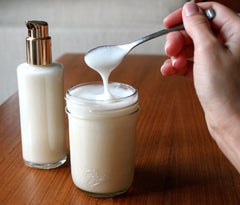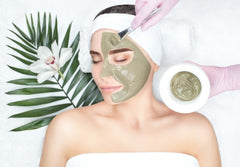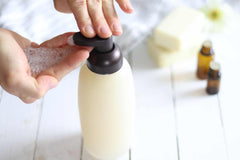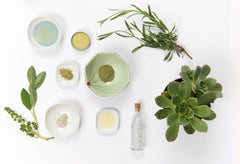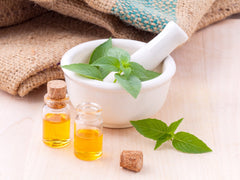Refresh Your Face with a Kaolin Clay Mask

Taking care of your face can be tough work. Doing so requires an intensive twice-daily routine. Even with proper care, damage from excess oil, acne, or excessive dryness can add up to create big problems over time.
To fight back against this, many people choose to receive chemical peels or use K-beauty sheet masks. But these solutions come with their own problems. As you search for a solution to your face-care needs, consider a natural alternative to harsh chemical treatments. Consider embracing the power of kaolin clay masks.
Below, you’ll find everything that you need to know about kaolin clay, how to use it, and what benefits it can provide to your face.
Here are some of the best products you can add to your kaolin clay masks:
- Kaolin clay for the base of your DIY face mask
- Organic Witch Hazel Hydrosol to reduce redness
- Eucalyptus Essential Oil to support anti-inflammation
What is kaolin clay?
Kaolin clay is also sometimes called “China Clay” due to its history. The clay was first obtained and mined on the Kaoling Hill in China. For centuries, it’s been used for porcelain manufacturing and as a homeopathic remedy within China.
Kaolin clay can occur naturally in several different colors, including pink and green, but is white in its purest form. The clay has a very soft texture and is rich in Kaolinite, a type of mineral.
What does kaolin do for the skin?
Kaolin supports a person’s skin in several key ways. Most importantly, it is one of the few types of clay that won’t dry out your skin when used. That’s because kaolin has a neutral pH level and is rich in silica dioxide. This means that kaolin clay is an excellent option for people with dry, sensitive, or older skin.
That’s not to say that kaolin clay masks won’t support the needs of people with other types of skin. For example, they’ve been known to absorb the excess oil that sits on the faces of people with oily skin. Since kaolin clay is incredibly mild, it’s able to absorb this oil without stripping away your skin to cause dryness.
Kaolin clay can also:
- Calm inflamed or irritated skin
- Fight acne
- Exfoliate your pores (without damaging sensitive skin)
- Tone your skin
Does a kaolin clay mask clear up clogged pores and spots?
Yes, this is one of the biggest reasons why people choose to use kaolin clay masks as a part of their skincare routines. The material has been proven to be effective as a natural exfoliator that clears up clogged pores.
In fact, kaolin clay is capable of clearing away all traces of dirt, pollution, grime, and bacteria that are on your face. Because it’s such a mild clay, kaolin can accomplish all of this without either drying out your skin or causing any redness or irritation. That makes it incredibly unique among skin care products.
Can kaolin be bad for my skin?
Kaolin clay is pretty mild as far as clays go, making it one of the safest skincare products on the market.
But it’s also extremely effective at clearing away excess oil on skin. This means that if it’s used in very high quantities, kaolin clay can dry out your face.
That said, there’s very little danger to using kaolin on your skin. If you’re still unsure about it, try applying a little bit to a small patch of skin that can be hidden by clothing. This will give you the chance to make sure your skin doesn’t experience any side effects from the substance before applying it to your face.
How do you make a kaolin clay face mask?
Preparing a kaolin clay face mask from scratch may sound too complex at first blush. But it’s a fairly straightforward process that you should have no difficulty carrying out with the right instructions.
With that in mind, here’s a step-by-step guide to making your very own kaolin clay face masks:
Step 1: Gather Ingredients
High-quality ingredients are an essential component of any kaolin clay face mask. This starts with finding the right kaolin clay. After that, you’ll also need water, hydrosol, and essential oils. (More details about ingredients are included in a later section).
You can get everything you need for your kaolin clay face mask by purchasing our Wellness Kit.
You’ll also want to put together the right tools for this project. That means getting a brush, a small wooden mixing bowl, and pipettes to count drops ready to go.
Step 2: Add Ingredients to a Small Bowl
Start by pouring 1 teaspoon of kaolin clay into the bowl. Then, add 20 drops of water, 10 drops of hydrosol, and your essential oils. Don’t overdo it with the essential oils. Just 1-3 drops each will do the trick.
Step 3: Mix
Once everything is in the bowl, you’re ready to begin mixing it all together. Do so gently until you reach the desired consistency. Ideally, the mixture should be a smooth, creamy paste when you’re done with it.
Step 4: Apply to Face
Before applying your kaolin clay mask, make sure to wash and pat-dry your face. Then, spread the mask evenly across your face with your brush. Set a timer for 10 minutes and wash off the facemask with warm water when you’re done.
How often should you use a kaolin clay mask?
In most cases, it suffices to use a kaolin clay mask once per week. If you have dry skin, then once a week is the maximum number of times that you should use this mask on your face.
It’s okay to use a kaolin clay mask more often if you have oily skin. If you do, then feel free to apply a mask as often as 2-4 times per week. Just keep in mind that if you begin to notice your face drying out, it’s time to take a break.
8 ingredients you should use in your kaolin clay mask
Using the right ingredients is an essential component of maximizing the benefits you receive from using kaolin clay masks. For the best results, we recommend using all-natural ingredients that support the long-term health of your skin instead of chemical ones that can detract from it.
Here are the top 8 ingredients that you should seriously consider using in your next kaolin clay face mask:
1. Kaolin Clay
Of course, every kaolin face mask begins with kaolin clay. This unique substance is unlike any other face care ingredient on the market. It’s packed full of skin-healing qualities and is mild enough to be used on every type of skin without causing irritation, dryness, or other problems.
2. Chamomile Hydrosol
Chamomile hydrosol is a must-have in any kaolin clay face mask recipe. It provides natural relief for soreness and is extremely effective at soothing aggravated skin. Chamomile has a relaxing, gentle effect that makes it an ideal ingredient to add to virtually any skincare product.
3. Lavender Essential Oil
Lavender essential oil is an excellent addition to your kaolin face mask no matter what type of skin you have. It’s an ingredient that’s widely used for its soothing, calming properties. Putting lavender in your kaolin clay face mask is the perfect way to unwind and relax after a long day.
4. Bergamot Essential Oil
Bergamont is widely-used in natural skincare products for its bright, citrusy scent and uplifting vibes. Adding bergamot essential oil to your kaolin face mask will lift your spirits without being overly stimulating or causing any other imbalances in your nervous system.
5. Rosehip Oil with 2% Vitamin E
If you have dry skin, then rosehip oil with 2% vitamin E should be included in any kaolin clay face mask recipe that you follow. It’s capable of providing a near-instant boost to tired-looking skin thanks to its nutrient-rich properties. The product includes a number of essential fatty acids, which help it to hydrate dry, itchy skin.
6. Organic Witch Hazel Hydrosol
Your kaolin clay face mask recipe needs to include at least one hydrosol. While many people use chamomile hydrosol, organic with hazel hydrosol could be a better option if you regularly deal with issues like facial redness, sunburns, or eczema and psoriasis.
Organic witch hazel has a long history of being used as a natural remedy for inflammation, irritation, and burns. It can even be combined with chamomile hydrosol to personalize your kaolin clay mask recipe even more.
7. Organic Eucalyptus Essential Oil
There’s nothing quite like the refreshing, uplifting scent of eucalyptus. If you’re looking to infuse a little extra rejuvenation into your kaolin clay mask, then organic eucalyptus essential oil is an excellent choice.
It combines antibacterial, antiseptic, and anti-inflammatory properties with a cleansing effect that will leave you feeling brand new after your next face mask.
8. Organic Tea Tree Essential Oil
Tea tree is used in many different natural skincare remedies for good reason. Its properties calm redness, swelling, and inflammation in the face.
This makes organic tea tree essential oil a good option for people who have been struggling with acne. Its anti-inflammatory properties can help you address both the acne that you currently have and the scars that may have resulted from previous outbreaks.



